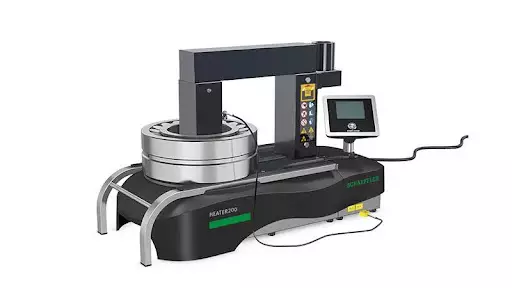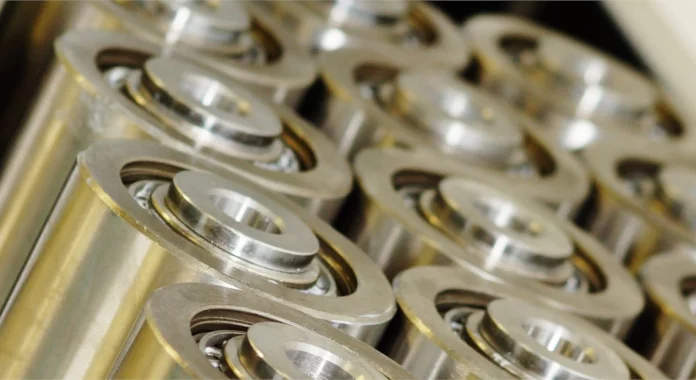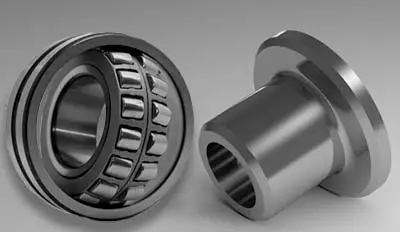
How to Mount or Remove a Bearing: Procedure Using Heat
Removing and installing bearings is an important skill that demands knowledge of the right equipment, procedures, and expertise. Proper bearing mounting techniques prevent damage to machinery and ensure successful long-term operation. In this article, we look into the methods of using heat for bearing mounting and removal. The use of heating for installing or removing bearings is essential for tight-fitting bearings.
Removing a bearing with heat involves evenly heating the bearing (using a heat gun or induction heater) to expand it, then quickly pulling it off the shaft once it has loosened. This thermal expansion method allows the bearing to come off without force.
How does heating a bearing help in removal?
The process of removing bearings using heat relies on the principle of thermal expansion. When a bearing is heated, it expands, causing an increase in its inner diameter. This expansion loosens the bearing’s fit, making it easier to remove from a shaft or housing. The key is to apply heat evenly and gradually, typically using a controlled heat source like a heat gun or an induction heater, to avoid uneven expansion or damage to the bearing and the surrounding components. The correct temperature must be reached to ensure sufficient expansion for removal but should not be so high as to alter the metallurgical properties of the bearing. This method is highly effective for interference fits or bearings that have seized due to corrosion or overuse.
Pacific International Bearing recommends the use of bearing induction heaters to let users control the process of mounting bearings onto a shaft or dismounting them with precision.
Methods, like torching or heating bearings in a hot oil bath, are difficult and do not have the control of an induction bearing heater
Induction heating is a non-contact, safe method for precisely heating electrically conductive materials, such as bearings, bushings, and gears. The heating process changes the physical properties of the bearing metal and allows the material or workpiece to harden, soften, or bond metals. This is especially useful not only for bearings but also gears, shafts, and axles.
Bearing induction heating is an easy solution to fit bearings onto shafts. Induction heaters create an oscillating electrical current that causes the bearing or metal to heat when placed in the device’s magnetic field. Eddy currents cause the bearing to heat and expand. Once the induction bearing heater reaches the target temperature, then it is time to remove the hot bearing with safety gloves and place it over the shaft. As it cools down, the bearing shrinks to fit.
Typically bearing induction heaters are safe, clean, and simple for replacing bearings safely, securely, and quickly on a shaft.
Maintenance teams can remove bearings without causing bearing damage or introducing particle contamination. We offer bearing induction heaters from FAG Bearing company which come in large, medium, and small sizes. We also offer a portable bearing induction heater.
Visit pibsales.com or contact us at [email protected]
Basics of Bearing Mounting Using Heat
FAG induction heating devices allow uniform, controlled heating of rolling bearings for easy handling. FAG induction heaters prevent damage during mounting and dismounting in a targeted manner.
FAG induction heating devices can be used for a wide range of applications. These include not only all conventional rolling bearings but also other ferromagnetic steel parts such as gears, clutches, and bushings.
Preparation Steps for Bearing Removal
The preparation steps for bearing removal using heat are essential for a safe and effective process. These steps include:
Safety Equipment Preparation – ensure you have all necessary safety equipment, including heat-resistant gloves, eye protection, and a fire extinguisher.
Workspace Preparation – clear the workspace of flammable materials. Ensure adequate ventilation to handle fumes or smoke.
Equipment Shutdown and Isolation – turn off and isolate the equipment from power sources. This prevents accidental activation during the removal process.
Selection of Heat Source – choose an appropriate heat source, such as a heat gun or induction heater, suitable for the bearing size and material. As mentioned we highly suggest using FAG induction heaters
Measurement Tools Ready – have tools ready for measuring temperature, ensuring the bearing is heated to the appropriate level without exceeding its material limits.
Arrangement for Cooling -plan how to cool the bearing and machinery part post-removal to avoid thermal shock or warping.
Accessibility Check – ensure the bearing is easily accessible for heating and removal. Remove any components that may obstruct the process.
Heated Bearing Removal Process
The heated bearing removal process begins with gradually heating the bearing, using a heat gun or induction heater, to expand its metal and loosen its fit. It’s crucial to apply the heat evenly around the bearing, avoiding direct flame contact, and to carefully monitor the temperature to prevent overheating. Once the bearing expands, it loosens on the shaft or housing, making it ready for removal. This step should be performed promptly as the bearing will start to cool and contract. Using appropriate tools, the bearing is then carefully removed. Post-removal, allow the bearing and the part it was attached to cool down slowly to room temperature to avoid thermal shock.
| Heating the Bearing | Gradually heat the bearing using the selected heat source. Ensure even distribution of heat to prevent warping or uneven expansion. Monitor the temperature carefully to avoid overheating. |
| Observing Expansion | Watch for signs of expansion. As the bearing heats up, it should loosen on the shaft or in the housing, becoming easier to remove. |
| Removal of the Bearing | Once the bearing is sufficiently expanded, carefully remove it using appropriate tools. This step must be done promptly as the bearing will begin to cool and contract. |
| Cooling Down | After removal, allow the bearing and the machinery part to cool down slowly to room temperature. Rapid cooling can cause thermal shock and damage. |
| Inspection Post-Removal | Inspect the shaft and housing for any damage post-removal. Also, check the removed bearing, if it’s to be reused. |
Finally, inspect both the shaft and housing and the bearing itself if it is to be reused, for any signs of damage. This detailed process requires a balance of precision, patience, and safety precautions to ensure effective removal without damaging the bearing or the machinery.
In conclusion, the process of removing bearings using heat is an easy solution when properly executed. Of course, this is an essential task in machinery maintenance and repair. It requires a methodical approach, balancing safety, precision, and technical knowledge. This process underscores the importance of understanding the material properties and the intricacies involved in bearing operations.
For professionals seeking quality bearings and expert guidance, Pacific International Bearing Sales offers an extensive range of bearings and induction heating tools.
Check our online store or contact us.
Frequently Asked Questions
Q: How do you remove a bearing using heat?
A: To remove a bearing using heat, you evenly heat the bearing (for example, with a heat gun or induction heater) so that it expands and loosens its grip. Once the bearing is hot enough to have expanded, you quickly and carefully pull it off the shaft using appropriate puller tools and heat-protective gloves. This method uses thermal expansion to free the bearing without excessive force.
Q: What is an induction heater used for in bearing removal?
A: An induction heater is a device used to heat metal parts (like bearings) in a controlled, non-contact manner. In bearing removal, an induction heater rapidly and evenly heats the bearing by creating an oscillating magnetic field, causing the metal to expand. This makes the bearing easier to remove from a shaft. It’s safer and more precise than using an open flame, since the heat is uniform and can be controlled to avoid overheating the bearing.
Q: What safety precautions should you take when removing a bearing with heat?
A: Key safety precautions include wearing heat-resistant gloves and eye protection, and ensuring the workspace is clear of any flammable materials or fluids (have a fire extinguisher nearby just in case). Make sure the machinery is turned off and electrically isolated before you begin. Apply heat gradually – do not use an open flame directly on the bearing (this can damage the bearing or create a fire hazard). Good ventilation is important if heating produces smoke or fumes. Always handle the heated bearing with proper tools (never with bare hands) and allow parts to cool naturally before touching them.
Q: What temperature should you heat a bearing to for removal?
A: Typically, you only need to heat a bearing to around 80–120 °C (176–248 °F) to expand it sufficiently for removal. In practice, many technicians aim for roughly 110 °C (230 °F) as a safe heating temperature. It’s important not to exceed about 120–130 °C, because higher heat can alter the bearing’s metallurgy or ruin any lubrication. Most induction bearing heaters have temperature controls or presets (often at 110 °C) to prevent overheating while still allowing enough expansion for easy removal.
Q: How do you mount a bearing using heat?
A: To mount a bearing using heat, you heat the bearing (usually with an induction heater, oven, or oil bath) so that its inner diameter expands slightly. Once heated, you swiftly slide the bearing onto the shaft to its proper position. As the bearing cools, it contracts and forms a tight interference fit on the shaft. This method avoids the need to force the bearing on with excessive pressure. For safety, the same precautions apply: heat the bearing evenly and wear protective gloves when handling the hot bearing. Heating for mounting is often done to a similar temperature range (around 100 °C) — just enough to expand the bearing without damaging it. As it cools, the bearing will grip the shaft firmly.


